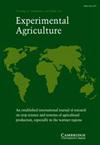Improvement of soil aggregate-associated carbon sequestration capacity after 14 years of conservation tillage
IF 1.9
4区 农林科学
Q1 Agricultural and Biological Sciences
引用次数: 1
Abstract
Summary The North China Plain is an important summer maize/winter wheat rotation area. However, over the years, continued intensive tillage has destroyed the soil aggregate accelerating the mineralization and decomposition of soil organic carbon (SOC), which plays an important role in soil quality, as increased organic carbon storage improves soil fertility and crop yields. Thus, the objective of this study was to explore the comprehensive impact of tillage methods on soil aggregates, aggregate-associated SOC, and carbon sequestration capacity under a regime of straw return. In 2002, we started a 14-year long-term tillage experiment; then in 2016–2017, we tested the following tillage methods, zero tillage (ZT), rotary tillage (RT), subsoiling (SS), and conventional tillage (CT). The results showed that in the 0–10 cm soil layer, tillage methods significantly reduced the proportion of aggregates in the order of 2–0.25 > 5–2 > 0.25–0.053 mm. Additionally, conservation tillage (i.e., SS and ZT) significantly increased the percentage of macroaggregates (0–40 cm) and their SOC content, compared to CT. Additionally, the contribution rate of macroaggregates to SOC was 17.2% and 30.6% higher under SS and ZT than under CT, respectively. Conservation tillage methods improved the carbon sequestration capacity of soil aggregates. Our study provides a theoretical basis for the development of more suitable tillage methods. Furthermore, long-term conservation tillage seemingly protected large aggregates and, SOC, whereby carbon sequestration was enhanced and soil carbon emissions were effectively reduced.保护性耕作14年土壤团聚体相关固碳能力的提高
华北平原是重要的夏玉米/冬小麦轮作区。然而,多年来,持续的集约耕作破坏了土壤团聚体,加速了土壤有机碳(SOC)的矿化和分解,这对土壤质量起着重要作用,因为有机碳储量的增加提高了土壤肥力和作物产量。因此,本研究的目的是探讨秸秆还田条件下耕作方式对土壤团聚体、团聚体相关有机碳和固碳能力的综合影响。2002年,我们开始了一项为期14年的长期耕作试验;然后在2016-2017年,我们测试了以下耕作方法:免耕(ZT),旋转耕(RT),深耕(SS)和常规耕作(CT)。结果表明:在0 ~ 10 cm土层,耕作方式显著降低了2 ~ 0.25 > 5 ~ 2 > 0.25 ~ 0.053 mm的团聚体比例;此外,保护性耕作(即SS和ZT)显著提高了0 ~ 40 cm大团聚体的百分比及其有机碳含量。此外,与CT相比,SS和ZT对土壤有机碳的贡献率分别提高了17.2%和30.6%。保护性耕作方式提高了土壤团聚体的固碳能力。本研究为开发更合适的耕作方法提供了理论依据。此外,长期保护性耕作似乎保护了大团聚体和有机碳,从而增强了碳固存,有效减少了土壤碳排放。
本文章由计算机程序翻译,如有差异,请以英文原文为准。
求助全文
约1分钟内获得全文
求助全文
来源期刊

Experimental Agriculture
农林科学-农艺学
CiteScore
2.50
自引率
6.20%
发文量
29
审稿时长
24 months
期刊介绍:
With a focus on the tropical and sub-tropical regions of the world, Experimental Agriculture publishes the results of original research on field, plantation and herbage crops grown for food or feed, or for industrial purposes, and on farming systems, including livestock and people. It reports experimental work designed to explain how crops respond to the environment in biological and physical terms, and on the social and economic issues that may influence the uptake of the results of research by policy makers and farmers, including the role of institutions and partnerships in delivering impact. The journal also publishes accounts and critical discussions of new quantitative and qualitative methods in agricultural and ecosystems research, and of contemporary issues arising in countries where agricultural production needs to develop rapidly. There is a regular book review section and occasional, often invited, reviews of research.
 求助内容:
求助内容: 应助结果提醒方式:
应助结果提醒方式:


